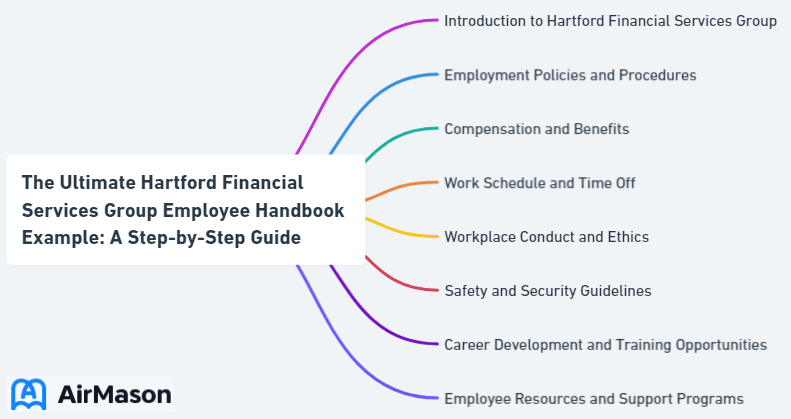
Employee handbooks are essential tools for small business owners, helping to establish a well-organized work environment while ensuring transparent communication. The Hartford Financial Services Group Employee Handbook Example serves as an exemplary model, showcasing the importance of company culture, values, and key policies. In this blog post, we will explore the lessons that can be drawn from the Hartford Financial Services Group Employee Handbook example and provide guidance on crafting your own effective employee handbook, tailored to your company’s needs.
Key Takeaways
- Understand the Hartford Financial Services Group Employee Handbook and use it to create your own.
- Establish clear expectations, provide comprehensive benefits & leave policies, protect trade secrets & confidential information.
- Consider legal requirements when creating an employee handbook tailored to company needs with industry regulations and mission/vision statements.
Fortune 100 Company Employee Handbook Example
In this illustrative Fortune 100 company employee handbook example, we delve into the comprehensive guidelines and policies that shape the organizational culture. The Fortune 100 company employee handbook example sets the standard for best practices, covering a wide array of topics such as workplace conduct, benefits, and professional development. Employees within this esteemed organization can refer to this handbook for a clear understanding of expectations and rights. It serves as a valuable resource, ensuring transparency and alignment with the company’s mission. This exemplar handbook reflects the commitment of a Fortune 100 company to fostering a positive and inclusive work environment, providing a blueprint for others in the corporate landscape.
Understanding the Hartford Financial Services Group Employee Handbook
An employee handbook compiles company policies, protocols, and the legal rights and obligations of employees. As a small business owner, you will find this beneficial for creating an organized work environment. The Hartford Financial Services Group Employee Handbook serves as a model for small businesses, showcasing the importance of company culture, values, and key policies.
We will examine the specifics of this exemplary handbook and offer insights on adapting and implementing these best practices for your business.

Company Culture and Values
The company culture of Hartford Financial Services Group includes the following values:
- People-oriented
- Opportunity-driven
- Valuing customer service excellence
- Sustainability practices
- Trust
- Integrity
- Diversity and inclusion
Their employee handbook demonstrates the company’s culture by emphasizing honesty, integrity, and ethical behavior through its Codes of Ethics & Business Conduct. Additionally, the handbook establishes the company’s vision, reinforcing the company’s values to employees. The company promotes a diverse and inclusive culture through its Employee Resource Groups and supports employee success through industry-leading resources and programs.
The Hartford Financial Services Group’s employee handbook maintains a professional and formal tone, shaping the workplace atmosphere. By incorporating their company culture and values into the handbook, they create an environment that fosters a strong sense of belonging and commitment among employees, ultimately contributing to the organization’s success.
Key Policies and Procedures
Policies and procedures provide clarity on expectations and regulations, promoting a productive work atmosphere. The Hartford Financial Services Group Employee Handbook covers a wide range of topics, such as:
- On-the-job conduct
- Overtime pay regulations
- Workers’ compensation coverage
- Safety and security measures
- Standards for safeguarding assets, internal documents, and customer information
This extensive coverage guarantees employees access to all requisite information and guidelines, including equal employment opportunity, aiding in preventing miscommunication and preserving a unified work environment.
The Family and Medical Leave Act (FMLA) is one example of a key policy covered in the handbook. The Family Medical Leave Act (FMLA) states that employers must provide up to 12 weeks of unpaid leave, job-protected leave period within a 12-month period for specific reasons, which does not include paid time. These reasons involve childbirth and childcare, caring for a sick family member, or tending to one’s own medical illness. By covering this and other significant policies, the Hartford Financial Services Group Employee Handbook provides employees with the needed knowledge and resources for their roles.
Crafting Your Own Employee Handbook: Lessons from Hartford
Drawing inspiration from the Hartford Financial Services Group Employee Handbook, you can create your personalized handbook by setting clear expectations, offering comprehensive benefits, and safeguarding confidential information. The following sections will provide guidance on each of these aspects, as well as tips on making your employee handbook accessible and engaging, and addressing legal considerations.
Establishing Clear Expectations
To foster a productive work atmosphere and ensure employees understand their duties and obligations, it is essential to establish clear expectations in your employee handbook. The code of conduct section should encompass general standards of acceptable behavior and any disciplinary procedures that have been established. By setting expectations for conduct, performance, and responsibilities, you promote a positive work environment where employees are empowered to succeed.
In addition to conduct expectations, your employee handbook should include performance metrics that employees are expected to meet. These metrics can be tailored to your specific industry and company needs, ensuring that employees understand the goals and objectives they are working towards. Including these expectations in your employee handbook will help create a focused and goal-oriented work environment.
Comprehensive Benefits and Leave Policies
The Hartford Financial Services Group Employee Handbook specifies the following benefits and leave policies:
- Income protection benefits
- Supplemental health benefits
- Life and loss benefits
- Disability insurance
- Leave of absence plans
By outlining these comprehensive benefits, including free lunches, retirement plans, and tuition reimbursement, during the annual open enrollment period, employees are aware of their entitlements and support options, and can make informed decisions about their personal and professional lives.
Income protection benefits, for example, provide financial support to employees in the event of an illness, injury, or disability. Supplemental health benefits offer additional health insurance plans that provide coverage for medical expenses not covered by the employee’s primary health insurance plan. By including such benefits and leave policies in your employee handbook, you demonstrate a commitment to your employees’ well-being and foster a supportive work environment.
Protecting Trade Secrets and Confidential Information
Safeguarding your business’s confidential information and trade secrets is crucial for maintaining a competitive edge and ensuring long-term success. By implementing policies that protect this information, you can prevent unauthorized disclosure and potential damage to your business. In your employee handbook, be sure to include policies that address the proper handling, storage, and disposal of confidential information and trade secrets.
One way to protect your trade secrets and confidential information is by having employees sign a non-disclosure agreement (NDA). This legally binding document establishes the terms and conditions for the sharing of confidential information and can help prevent unauthorized disclosure. By including such policies in your employee handbook, you can ensure that employees are aware of their obligations and responsibilities when it comes to handling your business’s sensitive information.
Making Your Employee Handbook Accessible and Engaging
An accessible and engaging employee handbook is essential for ensuring new employees comprehend your company’s policies and procedures, ultimately contributing to a positive work environment.
We will offer guidance on enhancing the accessibility and engagement of your employee handbook through online resources, visual elements, and regular updates.
Online Access and Resources
Providing online access to your employee handbook allows employees to easily reference policies and procedures from any location, ensuring they have the information they need at their fingertips. Various platforms that are suitable for providing online access to employee handbooks include:
- Blissbook
- Igloo Software
- FlipHTML5
- Airmason
- Google Docs
- Dropbox Paper
- Canva
For seamless online access, ensure easy access, use a user-friendly format, assure compatibility, update content regularly, implement security measures, provide training and support, and encourage feedback. By incorporating these features, you can enhance the user experience and make it simpler for employees to navigate and locate the information they require in your employee handbook.
Oneok Employee Handbook Example
In this Oneok employee handbook example, employees gain valuable insights into the company’s policies and procedures. The Oneok employee handbook exemplifies a comprehensive guide, covering essential topics such as workplace conduct, benefits, and safety protocols. Employees can reference this handbook to understand the expectations set by Oneok, ensuring a harmonious and informed work environment. The Oneok employee handbook example is designed to empower employees with the knowledge they need to navigate their roles effectively, fostering a culture of transparency and accountability within the organization.
Visual Elements and Examples
Incorporating visual elements and real-life examples into your employee handbook can make it more engaging and easier to understand. Visuals, such as:
- Graphics
- Comic strips
- Photographs
- Illustrations
can represent information in a clear and concise manner. By including eye-catching images and graphics, photographs, icons, tables, illustrations, graphs, and charts, you can help break down complex concepts and make the handbook more visually appealing and memorable.
Illustrations can also facilitate the comprehension of complex policy explanations by providing a visual representation of the information that is clear and concise. Additionally, they can provide examples and scenarios that demonstrate how the policies apply in real-life situations, further enhancing comprehension and application.
By incorporating visual elements and examples, you can create an engaging and informative employee handbook that effectively communicates your company’s policies and procedures.
Regular Updates and Revisions
Regular updates and revisions are key to keep your employee handbook in sync with current trends and developments. This helps maintain compliance, provide accurate information to employees, and address any changes in your organization’s practices or procedures. Moreover, regular updates and revisions demonstrate a commitment to transparency and effective communication with employees.
It is recommended that your employee handbook be reviewed and updated at least annually. By keeping your handbook up-to-date, you can ensure that it accurately reflects your company’s practices, policies, and procedures, providing employees with the most current information. Additionally, consider soliciting feedback from employees and stakeholders when updating the handbook, as this can help identify areas for improvement and further tailor the handbook to your company’s needs.
Legal Considerations for Small Business Employee Handbooks

Addressing legal considerations in your employee handbook, such as state and federal laws and employee acknowledgment forms, is crucial. Ensuring that your handbook is compliant with all relevant laws will protect your business from potential legal issues.
We will discuss the role of state laws and federal laws and employee acknowledgment forms.
State and Federal Laws

To ensure your employee handbook complies with all applicable state and federal laws, it’s important to familiarize yourself with these regulations, which may include the Fair Labor Standards Act (FLSA), Family and Medical Leave Act (FMLA), Title VII of the Civil Rights Act, Americans with Disabilities Act (ADA), Occupational Safety and Health Act (OSHA), Equal Pay Act (EPA), and others. Additionally, be aware of state-specific employment laws, such as minimum wage requirements, overtime regulations, paid sick leave, family and medical leave, anti-discrimination laws, and worker’s compensation laws.
Enlisting the assistance of an employment lawyer when formulating an employee handbook can provide guidance with respect to industry standards and help produce pertinent language. By ensuring your handbook adheres to state and federal laws, you can protect your business from potential legal issues and create a compliant work environment.
Employee Acknowledgment Forms

Employee acknowledgment forms are essential for providing legal protection to your business by demonstrating that employees have received and acknowledged your company’s policies and procedures. These forms typically consist of a single-page document that includes the employee’s signature, date, and occasionally the supervisor’s signature, indicating that they have read, understood, and will adhere to the policies, procedures, and guidelines outlined in the employee handbook.
The legal ramifications of employee acknowledgment forms include safeguarding your business by affirming that the employee received and recognized your company’s policies and procedures, which can be significant in legal disputes. By including employee acknowledgment forms in your handbook, you can ensure that employees are aware of their obligations and responsibilities, further protecting your business from potential legal issues.
Tailoring Your Employee Handbook to Your Company’s Needs

An effective employee handbook should cater to your company’s specific needs, considering industry-specific regulations, requirements, best practices, and your company’s vision and mission.
We will discuss tailoring your employee handbook to your industry and incorporating your company’s vision and mission to create a customized handbook reflecting your organization’s unique values and objectives.
Adapting to Your Industry

Customizing your employee handbook to address industry-specific regulations, requirements, and best practices is essential for ensuring a compliant and effective work environment. This may involve:
- Modifying company policies and procedures to reflect industry-specific standards
- Including industry-specific rules and regulations
- Communicating any changes or revisions to employees in a formal manner.
Examples of safety protocols and procedures, compliance with industry regulations, and job-specific policies and procedures can all be adapted to suit your specific industry. By tailoring your employee handbook to your industry, you can ensure that employees are aware of the unique requirements and expectations of their roles, fostering a more productive and informed work environment.
Incorporating Company Vision and Mission
Incorporating your company’s vision and mission into the employee handbook is essential for aligning employees with the objectives and principles of the organization. This can be achieved by including statements that articulate your company’s values, goals, and objectives, as well as ensuring your handbook contains policies and procedures that are consistent with your company’s vision and mission.
The Hartford Financial Services Group, for example, incorporates its vision and mission into its employee handbook by offering clear employee benefits that align with their dedication to ethical business practices, and integrating dental and vision plans with their group income protection and life insurance benefits.
By including your company’s vision and mission in your employee handbook, you can foster a strong sense of affiliation and commitment among employees, guiding their behavior and decision-making in accordance with your company’s values and goals.
Charles Schwab Employee Handbook Example
In the Charles Schwab employee handbook example, new hires gain valuable insights into the company’s core values, policies, and expectations. The Charles Schwab employee handbook example serves as a comprehensive guide, offering a roadmap for employees to navigate their roles and responsibilities within the organization. This document not only outlines the company’s commitment to fostering a positive and inclusive work environment but also provides essential information about benefits, code of conduct, and professional development opportunities. As employees refer to the Charles Schwab employee handbook example, they find a valuable resource that promotes understanding, alignment with corporate culture, and adherence to the high standards set by Charles Schwab.
Summary
An effective employee handbook is essential for establishing a well-organized work environment, promoting transparent communication, and ensuring compliance with all relevant laws and regulations. By taking inspiration from the Hartford Financial Services Group Employee Handbook, and following the guidance provided in this blog post, you can craft an engaging and informative employee handbook tailored to your company’s specific needs. Whether you’re a small business owner or an HR professional, creating a customized employee handbook is a critical step in fostering a positive and productive work environment that supports the success of your organization and its employees.
Frequently Asked Questions
What should be included in an employee handbook?
An employee handbook should include sections on company policies, benefits and compensation, workplace safety, and disciplinary guidelines. It should also include information about employee rights and responsibilities.
How do you create a simple employee handbook?
To create a simple employee handbook, include topics such as your mission statement, equal employment opportunity statement, code of conduct, compensation and benefits, communication and conflict-resolution policy, dress code policy, company dating policy, non-discrimination and anti-harassment policy, and any other required policies. Ensure to set the tone that reflects the company values and gather feedback from employees during the drafting process.
How do you organize an employee handbook?
Start by creating a preface to introduce the handbook, and then provide an overview of your company. Cover all time and attendance policies as well as conduct policies, and conclude with any benefits offered. This will create a comprehensive, organized employee handbook.
How long should an employee handbook be?
An employee handbook should be kept to a maximum of 30 to 40 pages, if possible, as longer handbooks may not get the attention they deserve.
What is the significance of an employee handbook for small businesses?
An employee handbook is an essential tool for small businesses, providing clarity on company culture, vision, atmosphere and regulations to ensure transparent communication.
Important Disclaimer:
The article presented here does not serve as a representation of the company’s actual employee handbook mentioned in this article.
Our discussions and insights regarding employee handbook are based on assumptions about what may be considered significant in this companies’ policies. These assumptions are drawn from available information and industry knowledge. Readers are advised that the content provided is for informational purposes only and should not be construed as an exact reflection of any company’s official policies or procedures. For precise and accurate details regarding a company’s employee handbook, individuals should refer directly to the company’s official documentation or consult with appropriate representatives.
Please be aware that the content on this page has been generated by using artificial intelligence language models and may contain errors, inconsistencies, or outdated information. It is provided as-is without any warranties or guarantees of accuracy. We strongly recommend using this content as a starting point for further research. We disclaim any liability for damages or losses resulting from the use or reliance on this content.